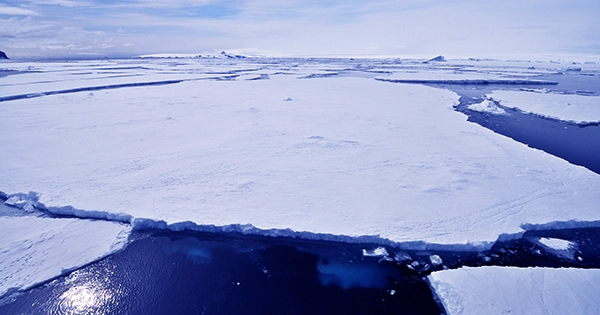The Amundsen Sea Embayment, which is the area of Antarctica that is changing the quickest, has lost more than 3,000 billion tons of ice over a span of 25 years, according to scientific calculations.
It would be more than 2 km tall, or 7.4 times the height of the Shard if all the missing ice were to be heaped on London. It would be 61 km long if it were to encompass Manhattan, or 137 Empire State Buildings stacked on top of one another.
The Amundsen Sea Embayment in West Antarctica, which is more than four times the area of the United Kingdom, is made up of twenty large glaciers and is a significant factor in the global ocean’s level.
Snow and ice hold so much water that if they all melted and leaked into the ocean, sea levels could rise by more than one meter.
The Amundsen Sea Embayment’s “mass balance” was computed as part of the study, which was directed by Dr. Benjamin Davison of the University of Leeds. This represents the equilibrium between the mass of snow and ice gained from snowfall and the mass loss from calving, which occurs when icebergs develop at the terminus of a glacier and calve off into the ocean.
The Embayment loses mass generally and aids in the rise in sea level when calving occurs more quickly than the ice is replenished by precipitation. Similar to how the Embayment can lose mass generally and add to sea level increase when snowfall supply decreases.
According to the findings, between 1996 and 2021, West Antarctica’s ice mass decreased by a total 3,331 billion tons, raising water levels by more than nine millimeters. The main causes of the glacier loss are believed to have been changes in ocean currents and weather.
Dr. Davison, a Research Fellow at the Leeds Institute for Climate and Atmospheric Science, stated that although there have been times when the rate of mass loss has slowed slightly, the 20 glaciers in West Antarctica have lost a tremendous amount of ice over the past 25 years.
“Due to the critical role the Amundsen Sea Embayment plays in sea-level increase, scientists are keeping an eye on what is occurring there. There are towns all over the globe that would experience severe flooding if ocean levels rose considerably in the coming years.
Extreme precipitation occurrences’ importance
The Amundsen Sea Embayment had several extreme snowfall occurrences over the 25-year research span, the scientists determined using climate models that depict how air currents travel around the globe.
These would have caused “snow droughts” or periods of very little precipitation in addition to times of heavy snowfall.
The experts’ estimates took into account these extreme occurrences. Surprisingly, they discovered that these events at times added up to half of the glacier change, and as a result, they were crucial to the Amundsen Sea Embayment’s input to sea level increase at those times.
For instance, the models indicated a “snow drought”—a time of consistently low snowfall—between 2009 and 2013. The ice sheet lost ice due to starvation from the absence of precipitation, which increased sea level rise by about 25% compared to years with normal snowfall.
In comparison, there was a lot of precipitation in the winters of 2019 and 2020. The experts calculated that this significant snowfall reduced the Amundsen Sea Embayment’s input to sea level to roughly half of what it would have been in an average year.
According to Dr. Davison, the long-term, widespread differences in the bulk of the West Antarctic ice sheet appear to be caused by variations in water temperature and circulation. They are likely to regulate the total sea level input from West Antarctica, so we need to learn more about them.
But “we were really surprised to see just how much periods of extremely low or high snowfall could affect the ice sheet over two to five-year periods—to the extent that we think they could play an important, albeit secondary role, in controlling rates of West Antarctic ice loss.”
“Ocean temperature changes and glacial dynamics appear strongly connected in this region of the world, but this work highlights the large variability and unexpected processes by which snowfall also plays a direct role in modulating glacier mass,” said Dr. Pierre Dutrieux, a scientist at the British Antarctic Survey and co-author of the study.
New glacier named
The Pine Island Glacier, also known as PIG, has been retreating due to the loss of ice in the area over the past 25 years.
One of its tributary glaciers split off from the main glacier and sped quickly as it receded. The tributary glacier has now been given the name Piglet Glacier by the U.K. Antarctic Place-names Committee so that future research can find and identify it without a doubt.
One of the study’s authors, Dr. Anna Hogg, an associate professor at Leeds’ Institute of Climate and Atmospheric Science, stated that the research “provides new estimates of how quickly this significant region of Antarctica is contributing to sea level rise in addition to providing new information on the role of extreme snowfall variability on ice sheet mass changes.
Satellite measurements revealed that the newly named Piglet Glacier increased its ice speed by 40% while the bigger PIG shrank to its narrowest reach in recorded history.
Scientists can now watch isolated areas and the extremely fast change occurring in Antarctica thanks to satellites like the Copernicus Sentinel-1 satellite from the European Space Agency, which employs sensors that can “see” through clouds even during the long Polar night.
















